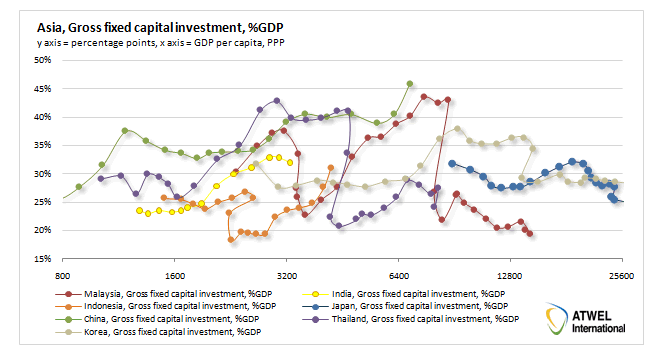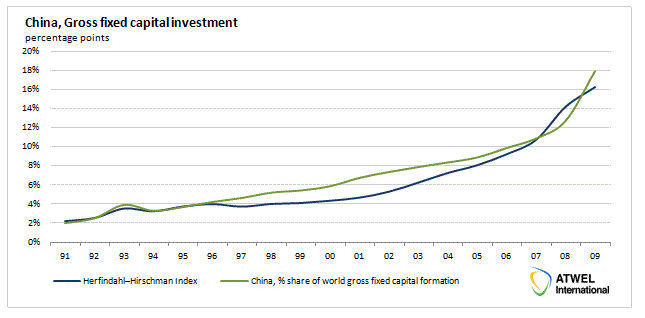As China grows bigger, implicit risk for commodities goes up
Commodities / China Economy Mar 11, 2011 - 03:59 AM GMTBy: Submissions
 Jan Kaska writes: This may sound counterintuitive, but we believe that as China grows bigger, it poses the biggest risk to commodities. No doubt, over the long term, commodities should remain structurally well bid as emerging Asia and developing countries will continuously have to tackle the infrastructure gaps. For example, countries like India and Indonesia have a lot of catch-up to do. Or recall Africa, where the Chinese have to build roads and ports first in order to obtain access to untapped reserves of valuable minerals. And China itself is not done with infrastructure in its homeland by any means as the Western provinces are still stuck deep in poverty.
Jan Kaska writes: This may sound counterintuitive, but we believe that as China grows bigger, it poses the biggest risk to commodities. No doubt, over the long term, commodities should remain structurally well bid as emerging Asia and developing countries will continuously have to tackle the infrastructure gaps. For example, countries like India and Indonesia have a lot of catch-up to do. Or recall Africa, where the Chinese have to build roads and ports first in order to obtain access to untapped reserves of valuable minerals. And China itself is not done with infrastructure in its homeland by any means as the Western provinces are still stuck deep in poverty.
Yet now comes the heretic thought. We believe bigger China does not imply riskless bet on commodities at all. Let us present couple of charts that prove our point.
On the first chart, you can see that China is running extremely high investment ratios to its GDP. As a matter of fact, almost half of China’s GDP is investment based. That means a lot of excess housing, factories, roads, etc. For sure, the capital stock is still very low in comparison to developed countries, yet in terms the actual phase of development in China, as measured by GDP per capita, the urban China is already experiencing some kind of excessiveness to the tune of 20-30%. The result is China has to slow down its investments otherwise it will run into trouble in a not too distant future. Especially given interest rates are on the way up.

Secondly, and probably more importantly, we have given a thought to the matter What is true role of China in the global investment boom? In order to respond to this question, one has to come up with some kind of methodology. The most obvious approach is to compute the share of Chinese investment to the global investment. We could simply call it a market share of China in commodities as fixed asset investments are the main commodity driver. However, we went a step further. What we are really interested in is the nature of the investment environment, how broad and diverse it is. We want to know whether the investment boom is driven by China itself or whether it is more broad-based? In order to measure this monopoly power, we employed the Herfindahl–Hirschman Index (HHI). HHI is a measure of the size of individual players in relation to the industry and an indicator of the amount of competition among them. As such, it can range from 0 to 1.0, moving from a huge number of very small players to a single monopolistic power. What we found is that as China rises, its monopoly power is also increasing. As the relevant market, we chose a universe comprised of developing countries, for we know that bulk of new investment and thus commodity demand will come from the emerging world. The HHI index rose to 16% which shows that investments are still broad-based, yet well less so than in 1991.

Global investment reached USD 13trn in 2009, China alone was responsible for adding 2.3trn, or roughly 18%. If we look only at investments stemming from the emerging world, we are talking about almost 40% share.
Now assume China gets forced by market forces (probably a collapse in the banking sector) to adjust its investment rate back to where it should be (with capital-output ratio at 2.5x and new structural growth rate of 8%, the implied investment rate is 34%). A 10% drop in investment rate would mean a loss of 25% of investments in absolute term or probably 25% drop in demand for commodities from China if you wish.
With a lot of emerging world dependent on Chinese vendor financing, and demand for commodities fueling domestic growth, we see little probability of these countries being able to step up, withstand the shock and increase investment spending.
Over 3-5 years, the internal growth of emerging markets (just as a response to population growth) would close this gap and that is why we think commodities will stay well bid structurally. Yet in terms shocks, make sure you get China right!
By Jan Kaska
Analyst with ATWEL International Hedge fund
© 2011 Copyright Jan Kaska, - All Rights Reserved
Disclaimer: The above is a matter of opinion provided for general information purposes only and is not intended as investment advice. Information and analysis above are derived from sources and utilising methods believed to be reliable, but we cannot accept responsibility for any losses you may incur as a result of this analysis. Individuals should consult with their personal financial advisors.
© 2005-2022 http://www.MarketOracle.co.uk - The Market Oracle is a FREE Daily Financial Markets Analysis & Forecasting online publication.



